|
Author Archive
Simon Maghakyan on 10 Aug 2008
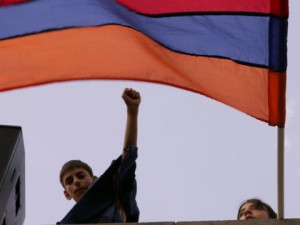
“If you are Turks, stay on the bus; if you are Armenians, get off and join us!” shouted an angry pro-opposition protestor after stopping a minibus in Yerevan on March 1, 2008. He then angrily looked at a woman with a child silently suggesting her to get off the bus to join Armenia’s former president Levon Ter-Petrosyan’s post election protest.
“Are you expecting me to get off a bus with my child?!” The angry woman’s response paid off, and she was left alone. That is left alone for a while.
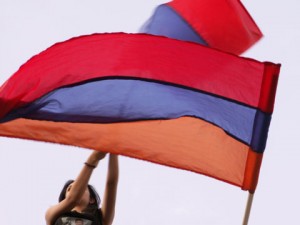
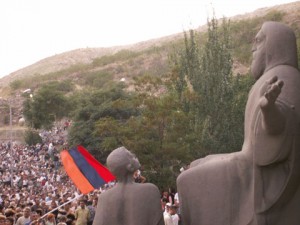
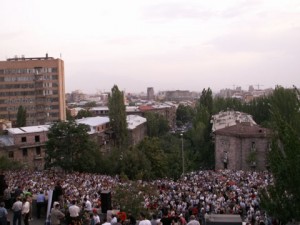
In a few days, after several people were killed on the day of the protest, there was a knock on this woman’s door – now it was the police looking for protestors. “Did you participate in the protest?” she was asked. After saying “no,” her husband was escorted out and taken to the local police department – he hadn’t participated in the protest either. In fact, the couple hadn’t event voted in the elections. Yet they were harassed twice – by the opposition and the government. This is a true story. It happened to someone I have known for all of my life.
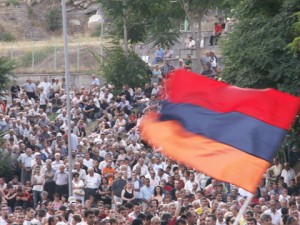
In these days there is no middle ground in Armenia. One will laugh at you if you say you are neutral. In fact, being neutral may be seen as something more sinister than being for one or the other. Tensions are high – a couple even divorced over the presidential election. Armenia’s brightest comedian Vartan Petrossian (no relationship to the former president) mentioned this in his “Love and Hatred” – a brilliant and well-attended play about Armenia’s political polarization.
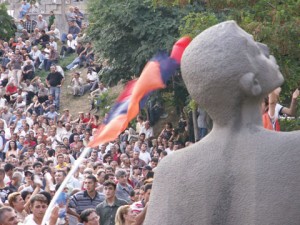
Vartan Petrossian’s message was clear – Armenia’s society needs love. But change should start by changing and improving ourselves. And women in politics can play an important role. Of course he delivered these messages with humor – and one wonders whether most of the audience got the point – especially in regards to women’s rights. In any case, the audience loved Vartan Petrossian.
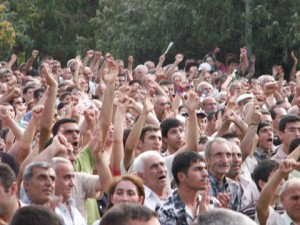
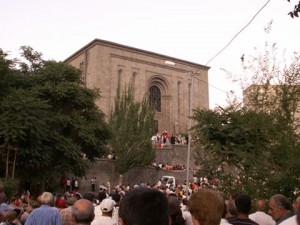
There was hardly any love on August 1 – when, according to Agence France Press, 5,000 people attended a pro-opposition protest outside Matenadaran (a manuscript depository). As my cousin and I were approaching Matenadaran, one of the speakers (who we couldn’t see) was urging to send the “current administration to grave.”
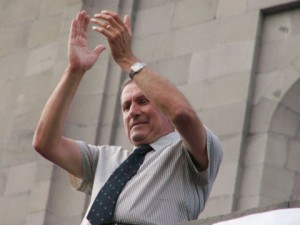
When Levon Ter-Petrosyan took over the podium, he was greeted with cheers by most of the crowd (others were seemingly observers like myself). Levon started his long, lecture-like speech making several points – Armenia’s legislative branch has become the tool of the executive branch, even Stalin didn’t pursuit such a totalitarian intimidation of opposition supporters, the current president won’t be able to solve serious problems such as environmental protection, etc. The last one was my favorite part of the speech. At last environment is getting some kind of attention by some group in Armenia – although it was mentioned as part of a long list that merely seemed to point the lengthy load of responsibilities that the government doesn’t work on.
Anyway, Levon’s speech was initially quite interesting. He got my attention when he said that since 1999, after he left politics, Armenia’s parliament had not voted against any proposal by the executive branch or overturned any veto by the president. He said that compared to the statistics when he was president (1991-1998), it “couldn’t be compared.” I am not kidding. I expected Levon to give some details or facts but his comparison was limited to saying that it couldn’t be compared. That was disappointing.
Anyway, I don’t want to sound like an anti-Levon activist. I actually have to agree with one of the people I interviewed that Levon’s presence in politics today is in many ways positive. He has built a very strong opposition and the government is, without doubt, concerned with the situation. Cosmetic or not, the new administration is making some reforms which would be unlikely had Levon been absent from Armenia’s politics.
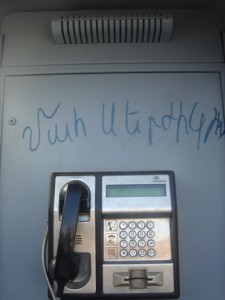
Yet it is ironic that most people who are for Levon do not love him; they hate Serge – Armenia’s current president. A phone booth had been vandalized with “Mah Serzhikin” (“Death to Little Serge”) resonating with one oppositionist leader’s message, as I have quoted above, to send the current government to grave.
A friend, who is pro-Levon due to being anti-Serge, suggested that the current president has the chance to use the March 1 event as an example of possible further clashes to pressure oligarchs out of economic monopoly in the country.
(Believe it or not, elimination of monopoly would make huge changes in Armenia. Armenia’s most competitive industry is perhaps the taxi service, and it is way the cheapest thing that Armenia offers. A thirty minute drive can cost as little as $3, and most short commutes are usually $2. This is because there are hundreds of taxi services in Armenia – no monopoly whatsoever – that is until the price for the monopoly-controlled natural gas goes up in early 2009.)
Another thing that needs improvement is the often-government-controlled media. Two hours before the start of the protest, when I was watching state-controlled public television’s 5:00 p.m. news, I didn’t see any information about the upcoming event at Matenadaran. Instead, Haylur – the news program – spent over five minutes talking about a jazz/fashion (not even mentioning where and why it took place) festival that had taken place the day before.
I had actually gone to the theatrical fashion event with several friends. It was pretty good, and I almost fell in love with one of the models there. That’s as close as I got to seeing love in public.
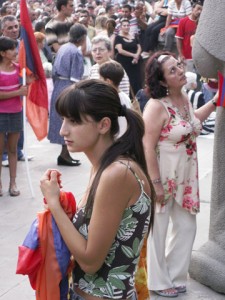
All photos by the author (copyright Blogian.net)
Simon Maghakyan on 09 Aug 2008
For those of you who live or will be in Los Angeles next week, do not commit the crime of not going to Armenian Navy Band’s concert. You have to go – even if you have to charge it on your credit card. Until 2007, I didn’t like the Band at all. But when I went to their concert, I fell in love with them. You will too.
Simon Maghakyan on 09 Aug 2008
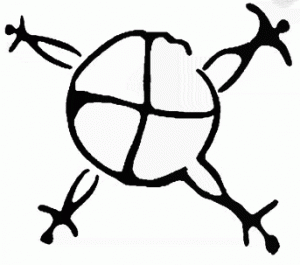 August 9 is the United Nation’s International Day of the World’s Indigenous Peoples, yet many people don’t know what “indigenous peoples” means. Ironically, the ongoing war in South Ossetia is of interest in indigenous studies. August 9 is the United Nation’s International Day of the World’s Indigenous Peoples, yet many people don’t know what “indigenous peoples” means. Ironically, the ongoing war in South Ossetia is of interest in indigenous studies.
Even though the notion of “indigenous peoples” sometimes may be vague, a definition of indigenous peoples that most scholars agree with was provided by the United Nations Special Rapporteur on minority and indigenous communities. Indigenous peoples, according to that articulation, are “…those which having a historical continuity with pre-invasion and pre-colonial societies that developed on their territories, consider themselves distinct from other sectors of societies now prevailing in those territories, or parts of them. They form at present non-dominant sectors of society and are determined to preserve, develop, and transmit to future generations their ancestral territories, and their ethnic identity, as the basis of their continued existence as peoples, in accordance with their own cultural patterns, social institutions and legal systems.”
I am currently editing an article that talks about Armenians and indigenous peoples. While Armenians, in general, have been considered “indigenous,” given that almost every nation in the Middle East and the Caucasus considers themselves native to their lands, the question of indigenous can be very controversial.
The ongoing war in South Ossetia and Georgia is a good example. While both Georgians and Ossetians have indigenous claims, both parts see each other as trying to steal a land that “belongs to them.” This idea of a land belonging to someone is, in principle, against core indigenous values (especially that of the ones in the western hemisphere). As one Native American chief has said, “the earth doesn’t belong to us, we belong to the earth.”
Some resources on indigenous peoples:
Cultural Survival Magazine
United Nations Permanent Forum on Indigenous Issues
Fourth World Center
Simon Maghakyan on 09 Aug 2008
The Caucasian Knot has an up-to-date coverage of the clashes between Georgians and Russians over South Ossetia.
Simon Maghakyan on 07 Aug 2008
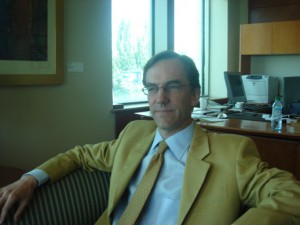 As diplomatic as the head of the U.S. Embassy Joseph Pennington is on record, America’s Chargé d’Affaires in Armenia cannot hide his love and sorrow for the tiny ex-Soviet republic he’s been working in since July 18, 2007. He is amazed with the Armenian people’s hospitality, and, without doubt, has many friends in the capital Yerevan. Equally, he resonates with ordinary peoples’ outrage against blatant inequality before the law – explaining that institutionalized change in the public sector will make people more tolerant and patient toward economic improvement. He also has to admit that the post-election March 1 clash between opposition supporters and the police, as a result of which at least 10 people died, has “complicated the relationship” with Armenia’s government. Yet he is hopeful; and regards current affairs as “good” and “productive.” As diplomatic as the head of the U.S. Embassy Joseph Pennington is on record, America’s Chargé d’Affaires in Armenia cannot hide his love and sorrow for the tiny ex-Soviet republic he’s been working in since July 18, 2007. He is amazed with the Armenian people’s hospitality, and, without doubt, has many friends in the capital Yerevan. Equally, he resonates with ordinary peoples’ outrage against blatant inequality before the law – explaining that institutionalized change in the public sector will make people more tolerant and patient toward economic improvement. He also has to admit that the post-election March 1 clash between opposition supporters and the police, as a result of which at least 10 people died, has “complicated the relationship” with Armenia’s government. Yet he is hopeful; and regards current affairs as “good” and “productive.”
Pennington’s wife and my good friend Amberin Zaman, a journalist for The Economist, was also present at this special interview with the chief of the U.S. mission in Yerevan on July 28, 2008.
Pennington’s desk is well organized with Armenian newspapers laying there. “Can you read Armenian?!” Pennington blushes “yes.” The well-trained diplomat’s office looks to the barely visible chapel of Yerablur – burial grounds for Armenian soldiers who fought in the Karabakh war. Pennington hasn’t been to Yerablur and, until our meeting, doesn’t know that the minute object on a hill several miles away is part of Yerablur.
Unlike in the case of the monument, Pennington recognizes the tragic consequences of the conflict with Azerbaijan. I ask him about the destruction of Jugha – the largest medieval Armenian cemetery reduced to dust by Azerbaijan in 2005. I know that Pennington has watched my film (Amberin told me so a long time ago), and I know that he cares. But as a U.S. diplomat, he has to give me the same answer – “As a general matter, we encourage countries to preserve cultural monuments.”
The young diplomat seems open to change, but until U.S. policy shifts, neither he nor any other person in his place will use the word “genocide.” Instead, they will continue to speak of “mass killings, ethnic cleansing” or simply “the events of 1915.” As a political science major, I understand where he is coming from. Yet I play devil’s advocate and press on. The beautiful Amberin Zaman jumps in and asks her husband to tell me about their experience at the “Genocide Memorial and Museum” in Yerevan, which Pennington calls Tsitsernakaberd like locals do. The g-word is not the only way of acknowledging a history that haunts today’s reality.
Pennington tells me how he and Amberin spent four hours at Tsitsernakaberd two weeks ago. Hayk Demoyan, the Museum’s director, showed them a recently arrived shipment from the US of lace, art work and toys made and used by Armenians – including survivors who ended up in orphanages — before the Genocide. I read pain in Pennington’s voice – pain for an entire people and its culture lost — and perhaps also regret for not being able to speak about these events more directly in his official capacity.
Amberin Zaman reminds me to ask about the Turkish-Armenian relationship, a topic dear to her heart. (I had encouraged her to advise me during my interview as a professional journalist). Pennington gets excited. He says that the rhetoric in the last six months between Armenia and Turkey has been very positive. He calls Armenia’s president Serge Sargsyan’s invitation to Turkish president Abdullah Gul to watch a football match in Yerevan between both countries “a brilliant idea.” Then he asks me if I have roots in Anatolia. I smile and start the list: Urfa, Diyarbakir, Istanbul, Bayazet. He says that he hopes that the border will open soon – I nod in a hopefully romantic agreement.
While Pennington enjoys his job, he also has his worries. A few days after our meeting, the opposition will hold another protest on August 1, 2008. I ask Pennington whether George W. Bush ever congratulated Sargsyan for his election. He says “no,” and I understand that Armenia’s president is standing on somewhat shaky ground. Like another friend suggested later on that day, perhaps Sargsyan can use March 1 as an opportunity to rethink political power and bring change to Armenia – such as eliminating monopoly.
Seemingly tireless, Pennington is actually tired of one thing– having to do the duties of the Ambassador. After the firing of John Evans, America’s last Ambassador to Armenia who used the word “genocide” in public, Congress hasn’t been able to confirm an envoy (until August 1, 2008 when Marie L. Yovanovitch was confirmed as Ambassador) due to pressure by many Armenian-Americans. This was a topic I didn’t bring up. But as I had entered the Embassy, I saw a photo of John Evans, along with other former Ambassadors to Armenia, hanging on a wall. I looked at the photo with much pride. Speaking truth to power had place, although small, in a building representing the United States. But commitment can work in other ways too.
There are many things about Pennington that cry love for Armenia. Large, framed photographs of pomegranates, books about Armenia and its history are all over his office. Turkish researcher Osman Koker’s magnificent collection of Turkey’s Armenian heritage in old postcards is on his table – an invitation to guests to browse through a history that is thought to be forever lost. You can feel the Armenian spirit in an office that is sponsored to represent what America’s current administration defines as U.S. interests. Diplomatic or otherwise, Pennington has been the right guy for Armenia.
Simon Maghakyan on 18 Jul 2008
Blogian may not be updated until after August 5.
Simon Maghakyan on 15 Jul 2008
I received the following e-mail from my friend Ani in Las Vegas:
So I went to the bookstore this morning and the nice lady, who took my transaction, noticed on my ID that my last name ends in YAN and the first thing she says to me was ” are you Armenian?” and before I have a chance to reply “yes I am, and you?” she says ” oh just like the Kardashians!!!!”
I told her that we don’t claim them. I was afraid that this day would eventually come; we as people are now recognized for a big ass and a sex tape. :-{
Simon Maghakyan on 13 Jul 2008
Genocided, Islamized, assimilated, and few – Tokat’s handful of hidden Armenians in this northern city of Turkey still face institutionalized and societal discrimination. Local Turks don’t give them daughters to marry, and the local government doesn’t give them jobs to work. The only Armenian monument, a cemetery, is full of garbage and human waste left by its usual visitors – vandals looking for gold.
Amberin Zaman, Turkey’s reporter for The Economist, has published a column in the Turkish-language Taraf (July 10, 2008) detailing what she saw in a town once rich of Armenian life and culture. In her own words (translated by Amberin Zaman):
Recently I was in in Tokat, known as the breadbasket of Turkey and for its lush green vegetation. Tokat has been a city with a significant Armenian population, especially before 1915. […] Armenians living in the sancak of Tokat numbered 22, 733. There were seven Armenian churches and a monastery. Between 1910 and 1912, the magazine Iris was published first as a weekly, and later as a monthly newspaper. There were Armenians here, even if not that many, up until the 1960s. [According to the Dictionary of Toponymy of Armenia and Adjacent Territories, there were 400 Armenians in the 1930s and 40s – Blogian.] But today it is almost impossible to find traces of them. Their churches, houses, and schools have all been destroyed. Those who have remained are trying to continue their lives under the Muslim identity. But of course everyone knows they are Armenians.
The “secret” Armenians of Tokat, whose numbers are not known, are having problems. One man caught between his two identities who spoke to us on the condition that we not give his name said that the biggest problem was trying to find girls for their sons. “The Turks gladly take our daughters,” he said, “so our girls are very lucky.” But there is no one for our sons, because Muslims don’t give their daughters to Armenians.” (According to widespread interpretation in Islam, while it is fine to take on a non-Muslim girl, the same is not true of boys.) When we asked whether the boys could find Armenian girls to marry, the man shook his head. The reason is that Armenians, in a very modern practice, do not allow intermarriage to families of relatives going back seven generations. “Because our numbers are so small, we are all related in one way or another, so there are no eligible girls.” That being the case, the boys tend to migrate from Tokat, while the girls become assimilated.
Another problem that has cropped up in recent years is that Armenian residents can no longer get work from the municipality. While in the past the Armenians, who have been forced to work in the handcraft professions, had been able to get contract work from the municipal authorities, they complain that they have not been able to get work since the AKP came to power in Tokat. “They only give work to their own kind,” one said bitterly. Although we were unable to look into this further or confirm it with non-Armenians, there is one shame of the AKP municipality in Tokat that is clear for all to see.
The condition of the Armenian cemetery, the last remaining evidence of the existence of Armenians here, is a complete disaster. As soon as you go through the open, rusted door, you come across human waste, broken beer bottles, and all kinds of garbage. The condition of the graves, which we documented on film, is heart-wrenching. Most of them have been swallowed up by grass, while many of the gravestones that are visible are broken. Some of the headstones have been completely destroyed.
“People still come here to look for gold,” said Muharrem Erkan, a Tokat tour guide and one of the local directors of the Pir Sultan Abdal Association.
We didn’t get a chance to find out who is legally responsible for upkeep of the cemetery ? the Armenian Foundations? the municipality? — or what the laws and regulations say about this. But in fact that’s not what is important. Even non-practicing Muslims know that one of the fundamental principles of Islam is to show tolerance toward other religions. Tokat’s AKP Mayor, Adnan Cicek, needs to correct this human disgrace. He needs to get a lock for the gate, paint it, clean out the garbage, trim the grass, and for God’s sake plant a few trees and flowers there. We know that Mr. Cicek, who was deemed worthy of the title of Mayor of the Year, can succeed in getting this done, especially since the rest of the town is beautifully kept and perfectly orderly. It’s too late for those who have died, of course, but let us at least show respect to those of our Armenian citizens who remain here. NOW! PLEASE!
[…]
Simon Maghakyan on 08 Jul 2008
I am one of the few people on Earth who accept the following news with sorrow: UNESCO has listed three ancient and beautiful Armenian monasteries in the territory of Iran on its World Heritage List.
While I am happy to see Armenian culture getting appreciated and Iran’s tolerance of Armenian Christianity being noted, I hate the fact that I read more behind these simple lines than most people would:
“[…]
[These churches] are the last regional remains of this culture that are still in a satisfactory state of integrity and authenticity.
[…]
One of these churches is part of the ancient Armenian city of Jugha (Djulfa), much of which today exists in the region of Nakhichevan, Republic of Azerbaijan. In September 2007, when UNESCO officials visited northern Iran to survey the Armenian monuments, they were shown a military rifle range across the border in Azerbaijan. That rifle range, until December 2005, housed the world’s largest medieval Armenian cemetery – Djulfa.
UNESCO did nothing to stop or condemn the final destruction of Djulfa. Now UNESCO lists these churches in a silent acknowledgment that the world’s largest Armenian historic site was erased, and in an indirect suggestion to forget about the tragedy.
Instead of listing these three different churches as one protected site, UNESCO should have listed the church at old Djulfa as part of a larger UNESCO site (like they did in 2003 with the Bamiyan valley after the Buddhas were destroyed in 2001) – including that rifle range which was a cemetery only a couple of years ago.
Simon Maghakyan on 08 Jul 2008
In a surprising move, one of Armenia’s strongest women officials has been fired for corruption allegations.
Alvina Zakaryan is a member of the so-called Karabakh clan (like the current president). Her agency, the Department of Passports and Visas at the Armenian Police (commonly known as OVIR), is widely considered to be Armenia’s most openly corrupt agency.
While firing Zakaryan is quite cosmetic – OVIR was really damaging Armenia’s image – it is interesting to see how the “fight against corruption” will continue in Armenia.
« Previous Page — Next Page »
|
|











 August 9 is the United Nation’s
August 9 is the United Nation’s 